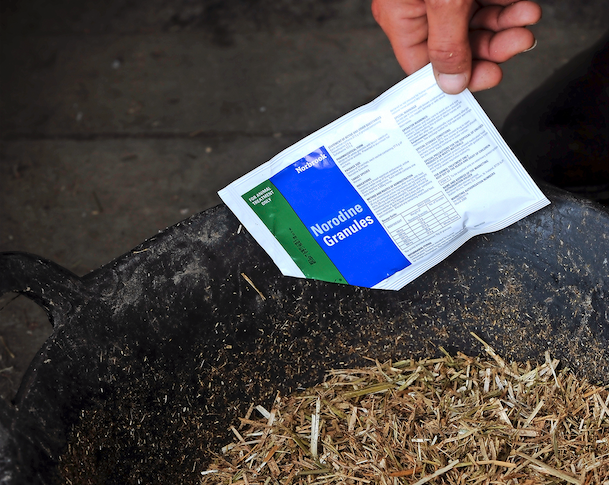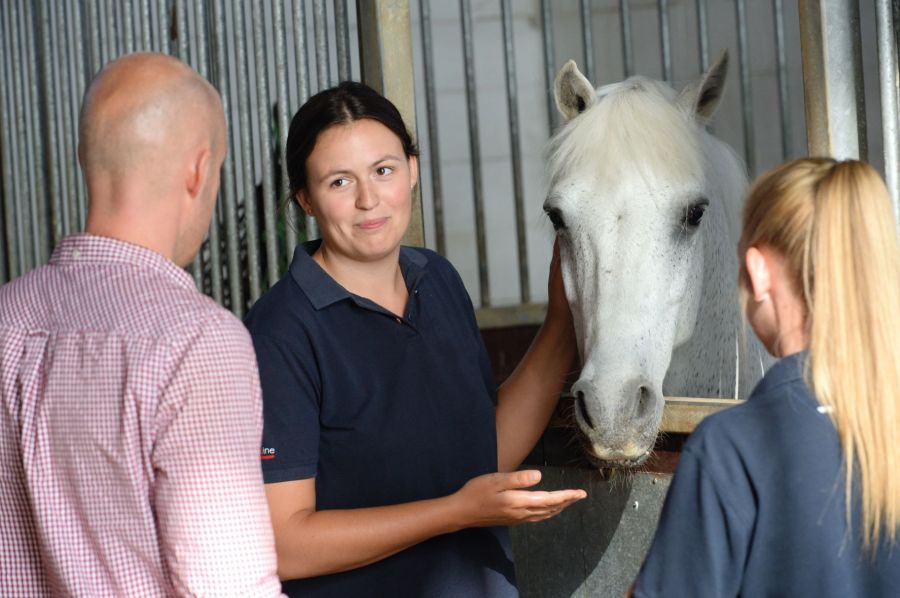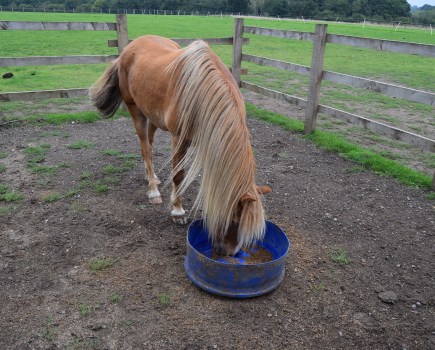At some point in their life, your horse is likely to be prescribed a course of antibiotics by a vet. You’ll tear open the packet of powder and mix it into their hard feed, hoping you’ve disguised it well enough for your horse to eat the medicine in full. Potentially, these antibiotics will save your horse’s life.
So what if these drugs stop working? Resistance to antibiotics is on the rise and it is a serious threat to horse health (and humans) right now. If we are not careful, antibiotics will stop working and we might not be able to save our horses in the future.
Without fully effective antibiotics to administer, something as simple as a cut could become infected and kill our horses.
What does resistance mean?
Antimicrobial resistance (AMR) refers to resistance developed by bacteria to antibiotics. It has been classified as a disease in its own right.
It’s now a clinical problem on an international scale and one of the largest threats to both equine and human health. So why is it only being flagged up with such urgency now?
Dr Kirstie Pickles is a European specialist in equine internal medicine and clinical assistant professor at University of Nottingham’s School of Veterinary Medicine and Science. She is a world-renowned vet and, according to her, antibiotics have been used for a long time.
However they’ve been used extensively and not always appropriately.
“If people are given five days’ worth of antibiotics for their horse, they’ll often only use three days’ worth, until the clinical signs of an infection have gone. Then they save the remaining antibiotics to give to their horse at a later date, without the guidance of a vet,” states Kirsty.
“Not finishing a full course of antibiotics means not all offending bacteria will be killed, increasing the likelihood of resistance developing.”
What are antibiotics?
An antibiotic is a type of medication that is used to treat bacterial infections. It is not effective for viral infections, such as horse flu.
Antibiotics work by either killing bacteria or inhibiting their growth, thereby helping the horse’s immune system to overcome the infection.
They can be classified into several categories based on their mechanism of action and the types of bacteria they target.
Antibiotics are commonly prescribed by healthcare professionals to treat a wide range of bacterial infections in horses (and people), including those of the respiratory system, urinary tract, skin and more serious conditions, such as pneumonia and sepsis.
“It sounds like a miracle drug and it truly is,” says equine vet Lucinda Ticehurst. “However, extensive use and overuse over decades has seen resistance to antibiotics rise to dangerously high levels. Today vets have to exercise extreme caution when prescribing them.”
Risk factors
Two of the most serious times I can remember giving my horses antibiotics was when one ex-racehorse had peritonitis, and another Thoroughbred mare suffered a puncture wound on a hind fetlock, which became infected. Both horses survived after being prescribed a course of antibiotics by my vet.
Without those antibiotics, they probably wouldn’t have. And that, sadly, could well become reality if antimicrobial resistance continues to rise.
While the issue of resistance to horse wormer is a well-known and frequently discussed threat to equine health, AMR is not and it is in urgent need of attention.
“While we’ve certainly not got parasite resistance under control yet, worming is something owners do regularly with their horses, which means it’s become better publicised and understood,” says Dr Kirstie Pickles.
“On the other hand, most horse owners won’t often have to give their horses antibiotics. It’s far more unusual and the issues surrounding AMR are therefore less well understood, despite the related risk factors being much greater.”
Antibiotics in horse feed

Sometimes under dosing is the result of horses refusing to eat feed containing the antibiotics they need.
The advice of recently retired equine vet Kieran O’Brien is to mix antibiotics with water to create a paste, which can then be administered to your horse via syringe, much like when worming.
Kieran used to treat my horses when I lived in Devon and I used this trick for one particularly crafty mare in her mid twenties who would instantly refuse feed the second any medicine was added to it.
Even if I tried to disguise it with a garlic and tasty sugar beet, it would still be a firm ‘no’ from Prudence, so syringe it was.
Lucinda Ticehurst suggests that an alternative method is syringing the medication. Mixing the antibiotics with yoghurt and a small amount of honey provides a sticky and tasty accompaniment.
‘Antibiotics are not without risk’
To tackle the problem of resistance to horse antibiotics and increase awareness about this growing issue, the British Equine Veterinary Association (BEVA)’s Antimicrobial Awareness Week runs every November.
In 2023, its main message was alerting horse owners to the risks of ‘hoarding’ antibiotics and storing them for use another day.
BEVA said the responsible use of antibiotics (also known as antimicrobials) is essential to help prevent widespread resistance and to ensure continued availability of antimicrobials both in terms of effectiveness and legislation.
“Giving random, left over or old antibiotics to your horse for a suspected infection is irresponsible and potentially dangerous,” said former BEVA President David Rendle, RCVS and European Specialist in Equine Internal Medicine.
“It could make things worse, as they might not be the right type of antibiotic for that specific infection and could easily contribute to the problem of resistance.
“People also forget that antibiotics are not without risk and their use can trigger serious – even fatal – intestinal disease.” Read our full story here.
Guidance for vets
BEVA’s guidance for vets around horse antibiotics is to self-regulate, only giving antibiotics when cases absolutely require them and being more selective about the types of antibiotic they use.
“Particular antibiotics used in human medicine are the same as those used in animal medicine,” adds Dr Kirstie Pickles.
“New antibiotics are only licensed infrequently, which means we have to be strict on our use of the antibiotics we have.
“Added to this, very few are licensed for use in horses. In fact, there’s only one antibiotic licensed for oral use in horses. Others can be injected, but this is much harder for owners to do themselves.”
New study finds increasing resistance
A study by Marshall and Marsella published in January 2024 set out to determine how common antibiotic-resistant infections are in horses, particularly Staphylococcus species.
These are bacteria that are normally found on the skin of horses. Previous studies documented antibiotic resistance in horses but did not focus on skin specifically.
“We investigated antibiotic resistance and correlations between resistance patterns in skin infections,” say the researchers.
“Overgrowth of [Staphylococcus] bacteria can lead to infection. In recent years, the emergence of resistance to antibiotics to treat these infections has been shown with these bacteria in humans and dogs.
“Determining how widespread Staphylococcal resistant bacteria are in horses helps to educate the veterinary profession on potential changes to horse resistance.
“This can help guide appropriate antibiotic usage as well as prove the need for innovative treatment options for both veterinary and human medicine.”
The study found increasing resistance to horse antibiotics and also found that Staphylococcal bacteria affects the resistance.
Researchers concluded that “larger studies with more horses are needed to evaluate the clinical usefulness of these results”. You can see the fully study here.
BEVA warning
As part of its ‘Safeguarding Antibiotics Fact Sheet’, BEVA states that antibiotic drugs are “essential” for the treatment of bacterial diseases in humans and animals. This is why all healthcare professionals — including vets and doctors — are working together to further limit the spread of antibiotic resistance.
“Resistance occurs when bacteria mutate their genetic code so antibiotics can no longer kill them. Some bacteria can then pass this acquired resistace to other bacteria either in the same animal, another animal, or even in [people].”
BEVA’s key message is two-fold:
- Every time an antibiotic is used, there is potential for bacteria to become resistant to that drug.
- Every time an antibiotic is used when it is not essential, the risk of resistance outweighs any potential benefit of the drugs.
Therefore, “it is vital that antibiotics are used very carefully to ensure they are available to help our horses for as long as possible.”
When not to use antibiotics
Antibiotics can treat a bacterial infection, but they have no effect on viruses — it’s the same in people as well as horses. So listen to your vet when they say “no”; it’s probably because antibiotics would be ineffective. Common health problems that require veterinary attention that usually don’t require horse antibiotics are:
- Strangles — this is because the abscesses that form as a result of this infection is your horse’s natural healing response to the bacteria.
- Hoof abscesses — pain relief may be prescribed by your vet, but antibiotics isn’t usually necessary. In fact, giving a horse antibiotics can actually slow down the healing process.
- Diarrhoea — this isn’t usually caused by bacteria and antibiotics can actually make it worse, because they kill the ‘good’ bacteria that’s in a horse’s stomach as well as the bad.
- Foals aren’t born with natural immunity, but they can get antibodies from the mare’s first milk, which is called colostrum. This is why the early feeds are so crucial (it’s the same in human babies too). According to BEVA, if a foal is healthy there is no benefit from treating them with antibiotics.
Download the full ‘Safeguarding Antibiotics Fact Sheet’ from BEVA here.
Using horse antibiotics correctly
Ultimately, prevention is the best chance we have of slowing down resistance to horse antibiotics and there are things every horse owner and rider can do to help this happen, including:
- Always follow the advice of your vet and only ever give antibiotics when they’ve been prescribed.
- If horse antibiotics are recommended by a vet, do all you can to ensure your horse gets the dosage they need.
- Make sure you administer the full course of horse antibiotics, even if they make a speedy recovery. The full course will be prescribed based on several factor, including your horse’s size/weight, which means only the full amount will be able to kill the infection they are fighting.
- If you have any ‘old’ antibiotics stored in your feed room, give them back. Never self-medicating, as you could be giving the wrong thing and make matters worse, and don’t use out-of-date antibiotics, which could be less effective.
- Start a conversation about growing resistance to horse antibiotics. The more horse owners and riders that know about it, the quicker the message will spread. Only by working together can we safeguard the future for our horses.
- Remember, adds Dr Kirstie Pickles, that “prevention is always better than treatment. This means better biosecurity and good horse management and care to prevent infections in the first place.”
‘It’s time we all take responsibility’
Imogen Johns, a Fellow of the Royal College of Veterinary Surgeons and vet at B&W Equine Vets in Gloucestershire, says it’s time we all take responsibility in fighting the threat of resistance to horse antibiotics.
“Resistance to antimicrobials, including bacteria that are resistant to all commonly used antibiotics, does appear to be an increasing problem in horses,” she confirms. “These resistant bacteria can be part of the normal bacterial population of the horse, such as on their skin or the intestinal tract, but they can also cause infections, which become very difficult to treat.
“At present, the best way we know of minimising the development of resistance is to use antibiotics responsibly. That is, only use them when there is a true bacterial infection (not a virus!), and reserving so-called ‘powerful’ antibiotics only for severe and life-threatening infections.”
View BEVA’s ‘Protect Me Toolkit’ here









